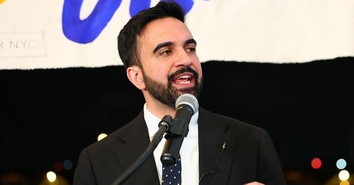Peter Jackson's The Hobbit Rings False

DVD Release Date: March 19, 2013
Theatrical Release Date: December 14, 2012
Rating: PG-13 for extended sequences of intense fantasy action violence and frightening images
Genre: Adventure
Run Time: 169 min.
Director: Peter Jackson
Actors: Martin Freeman, Ian McKellen, Cate Blanchett, Richard Armitage, Elijah Wood, Hugo Weaving, Andy Serkis, Christopher Lee
In the early 2000s, director Peter Jackson brought the sweeping, epic story of J.R.R. Tolkien’s The Lord of the Rings to meticulous life on the big screen. It was a large undertaking, based on an immense three-volume book. With so much story to tell, New Line Cinema staked its future on Tolkien’s tale, turning it into a trilogy of films. The result? Hundreds of millions of dollars in box-office grosses, capped off by a Best Picture Oscar win for the concluding film, The Return of the King.
When New Line and Jackson decided to team again to adapt Tolkien’s Rings prequel, The Hobbit (the film's first director, Guillermo del Toro (Pan's Labyrinth), dropped out but is one of four writers credited with its screenplay), there must have been a great temptation to expand what is a relatively slender single volume into multiple installments. However, the fact that The Hobbit, unlike The Lord of the Rings, is a story for children, presented certain pitfalls.
Nonetheless, the filmmakers gave in to temptation. Jackson and New Line decided to break The Hobbit, or There and Back Again into a three-part epic. The first installment, An Unexpected Journey, runs 169 minutes. If your gut tells you that such an approach to Tolkien’s slim children's tale might not work, then rest assured: your instincts are correct. Although The Hobbit: An Unexpected Journey finally takes hold in its final hour—when Bilbo Baggins (Martin Freeman) and Gollum (Andy Serkis) square off—the film is a long slog to reach that point.
Sixty years before the events of The Lord of the Rings, Bilbo is living contentedly in his hobbit-hole when Gandalf (Ian McKellen) pays him a visit to recruit him for a journey. He’ll join a group of dwarves on a mission to reclaim their homeland of Erebor, from which the dwarves have been chased by the dragon Smaug. Although initially reluctant to be part of the quest, Bilbo acquiesces and decides to help.
Less persuaded of Bilbo’s presence within the group’s ranks is dwarf leader Thorin Oakenshield (Richard Armitage), who, through encounters with elves and battles with trolls and orcs, remains unconvinced that the hobbit is more of an asset than a hindrance to the mission. But Gandalf, who has encouraged Bilbo’s inclusion, holds contrary beliefs.
The movie takes a full hour to set up the journey, and it's an hour that feels sorely padded. By the time Bilbo says, shortly after setting out on his journey, "Wait! I forgot my handkerchief!" and turns back toward home, you may have to restrain yourself from shouting at the screen, "No! Please, keep going!" The film at this point is already suffering from a lack of momentum.
Unfortunately, Jackson and his co-screenwriters (Fran Walsh, Phillipa Boyens, and del Toro) add so much Rings-style violence to Tolkien’s tale that The Hobbit earns a PG-13 rating—making the film inappropriate for younger audience members who otherwise might have enjoyed the storyline. At one point, Gandalf raises his own concerns about the story’s characters by declaring, "Save me from the stubbornness of dwarves. Your pride will be your downfall." That line could also apply to those who came up with the Hobbit-as-trilogy idea. Their insistence on expanding and bloodying-up The Hobbit could undo the goodwill built up by the extraordinary Lord of the Rings films.
The best part of The Hobbit—the battle of wills between Bilbo and Gollum—remains intact in this telling, and although it doesn’t arrive until the film’s final hour, it’s enough to inspire hope for the upcoming two films. Bilbo encounters Gollum, a pathetic creature preoccupied with a golden ring he calls "Precious," following a fit of self-doubt that causes him to separate himself from the larger group. The payoff is compelling. The Ring, as anyone who has seen or read The Lord of the Rings knows, has great power, and will end up with Bilbo—but not until a captivating dialogue between the two characters settles the issue of the ring's owner.
Filmed at 48 frames per second—twice the standard frames-per-second rate—The Hobbit has a hyper-real quality that works against expectations in a bad way. Rather than looking like something we’ve never seen before and giving the proceedings a greater sense of cinematic wonder, the higher frame rate accentuates a sense of artificiality about the film’s imagery. It’s closer to the look of a British TV production or even a soap opera at times, yet we’re supposed to embrace this new look as a great advance, a thing to be desired for all future films. If 48 frames per second has potential to redefine the viewing experience, The Hobbit doesn't point to obvious gains. It's simply another element that raises basic questions about the filmmakers' approach to the material.
The missteps of this first film do not bode well for the upcoming two segments of The Hobbit, but if Jackson and his cohorts can find a way to tone down the violence and kindle a gentler spirit in the subsequent chapters, they may yet salvage their adaptation. This movie is likely to leave Tolkien fans hesitant and uncertain about the upcoming films, while those new to The Hobbit will wonder why the story is so beloved. That's a long way from audience reaction to The Fellowship of the Ring, which left viewers eagerly anticipating what was to come.
CAUTIONS:
- Language/Profanity: "bal-s;" Dwarf scum;" "elvish filth"
- Alcohol/Smoking/Drugs: Pipe smoking; drinking
- Sex/Nudity: None
- Violence/Crime: A fire-breathing dragon; a head-butt greeting; an orc holds a human head, throws it; trolls steal horses and try to roast dwarves and hobbits over an open fire; trolls are killed; battles with orcs; an orc is thrown to his death, and others fall to their deaths; Gollum menaces Bilbo; a goblin cleaver; an explosion; Gandalf slays a goblin; kick to Gollum’s head
- Religion: Fate cited as the reason for Bilbo’s journey; a character is said to have never forgiven, or forgotten, a wrong; a character says, "Fate is with you;" a belief that only great power can hold evil in check is contrasted with another view about how acts of love and everyday things can overcome darkness
Questions? Comments? Contact the writer at crosswalkchristian@hotmail.com.
Publication date: December 13, 2012
Editor's Note: For a different perspective on The Hobbit, watch the video below, in which we name the film Crosswalk.com's Movie of the Year for 2012:
CrosswalkMovies.com: Top 10 Movies of 2012 from crosswalkmovies on GodTube.
Originally published December 13, 2012.







